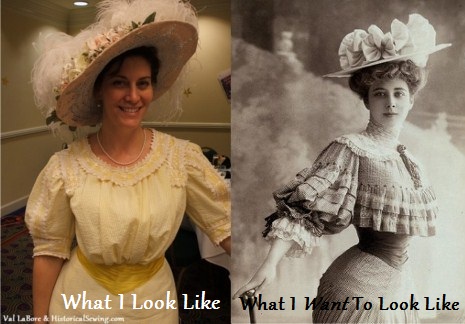
Reproducing historical costumes is a heavy task. We work and labor; we finagle and cry; we bleed and curse and cause our family to wonder why we do this crazy stuff for something we’ll display to the world once or twice.
It’s because we’re chasing after that elusive goal of hearing: “Wow! You look like you just stepped out of another time.” Music to our ears indeed.
So what makes us fail in getting that LOOK of the time period? Why do others seem to nail it on the head, whereas the rest of us wonder where we went wrong? How do we get our period wardrobe to look antique instead of like a costume?
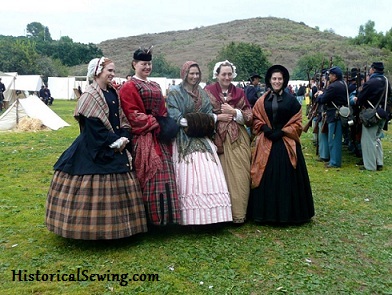
If you’re familiar with my article about you can’t be 100% accurate – it’s true: we will always fail as historical costumers because we weren’t there when it happened the first time. We look different and we act different.
Initially, you might say it’s all about the fit, which is hugely important as their garments were made specifically for them. They couldn’t walk into a Macy’s and buy something off-the-rack.
But you’ll see photographs with clothing that isn’t fitted very well. It’s actually kind of loose and poorly made. [I don’t think this is the look that most historical costumers are trying to re-create.]
However, you have to take into account everything that had been in their lives prior to that. It’s contemporary. It’s not like, “It’s now 1887 and I want to sew an 1887 dress.” No. It’s simply their clothing! I think that’s a huge part of why we miss the mark. Period clothing is not our everyday wear.
Aside from the fact that we’ll always fall a little short, I know of several instances where we as 21st Century dressmakers drop the ball when it comes to getting that “perfect” historical look.
#1 – Silhouette
I talk about silhouette often because this is where it all starts. An 1880 dress looks nothing like an 1838 dress because of the defined shapes & lines. A dress built over the right undergarments produces that historical picture you want.
So in building the silhouette, make sure you have all the proper garments to reflect that. For most of the 19th Century, this includes: chemise, drawers, corset, under-petticoat (if you want it), structure support and petticoats.
A decent corset will cover many decades. Just wearing one will make a difference.
Same thing with petticoats. WEAR THEM! Please. (Can you tell I’m passionate about them?)
A corset and two petticoats will take you so much further along the road toward “the ideal” than you think. Many costumers miss the importance of starting with a good foundation.
#2 – Seamlines
Accurately placed seams can catapult your creativity from “Costume-y” to “Period Clothing” in the time it takes to find your seam ripper. The Biggest Mistake? Not following seamline placement.
That shoulder seam – throughout the 1800s you’ll see it angled from the side of the neck toward the back of the arm. This is for fitting purposes primarily, but it’s also a telltale sign of a well-researched costume. Shoulder seams sitting right on the shoulder will scream modern.
Are your waist darts too far apart? Or too far from center front? Study originals and you’ll be thinking twice on sewing them exactly where that pattern tells you.
It’s not just where the seamlines are but why. The seam placement in garments back then were for a specific purpose – many times to follow the fashionable line, but also for fitting…which is a huge area of Epic Failure when it comes to pulling off a historical look.
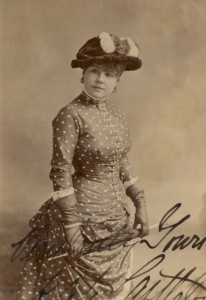
#3 – Fit
We all know fitting patterns to our particular figures is crucial to getting a period look. Of course, one can use poly costume satin to make a drop-dead, spot-on 1845 dress, which in all other circumstances is just awful, but if her fit is to the tee and the seam lines are in the proper place, she will look stunning…. But we’ll discuss the fabric mistake in a moment.
I think “perfect” fit is so elusive for us because we have our minds set on the fabulous photographs or museum mannequins where they are dressed so perfectly. The dress is filled out; there are no wrinkles, they’re all smooth. Same goes for when viewing fashion plates.
I think this gives us a false goal.
We compare it. It’s our 21st Century viewpoint of them. So when we see a costumer who has a perfect figure for, say the 1890s, and they make a 1890s costume, they ooze brilliance. They achieved that just-stepped-out-of-the-photograph look.
The Biggest Mistake is not one of avoiding a particular time period, but rather NOT taking your time to build the right silhouette, choosing elements from the period appropriate to your personal figure, and fine tuning the fit to match those photographs.
Fitting takes time and sometimes multiple mockups. Set yourself apart in the costuming realm by not making the mistake of rushing through the mockup stage.
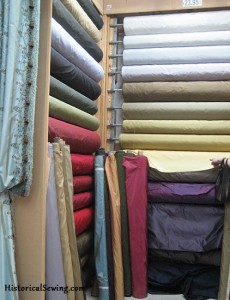
#4 – Fabrics
Oh, is fabric selection a Biggie Mistake when it comes to historical costumes! Right off the bat if a costumer selects a nylon taffeta or a polyester broadcloth, or doesn’t use enough of an appropriate material, that period garment will fall short of the look that’s desired.
Of course, fabric selection is by no means an easy task. Most of the time we end up using too-heavy fabrics. I did it often when I first started period sewing, and I still do it today despite my attempts to re-train my brain on what to use. It’s simply we don’t have textiles that drape the same way as the originals.
You want quality fabrics. Going the cheap route is a historical costumer’s mistake and will only disappoint. The project will turn out something hideous too, something you won’t be happy to wear, which only results in lost money and a sad dress that represents a dream you once had.
To look like part of history, costumers need to step up their knowledge of fabrics and be willing to save for the quality silks, the quilting cottons, and the handkerchief linens.
You can fake it sometimes, with blends like wool/nylon. However, remember that if you simply want to throw together a period garment but your budget isn’t up to speed, even with great fit, you will miss the mark. (But don’t worry – if you make fabric selection mistakes, you are in cozy company with most casual costumers.)
#5 – Trims
Placing trims haphazard doesn’t work. Merely slapping on a 3″ ruffle at the hem won’t cut it. It has to mean something. It has to have purpose there. Is it to balance the overall design? Is it connected to the other elements of the garment?
Trimming the wrong way or not applying enough trim (which is probably a huge portion of our Biggest Mistake #5) skews the look toward amateur. It begs the observer to think: 1) you didn’t do your research, 2) you ran out of time, or 3) you didn’t have enough money to purchase trims that would complete the look.
Just as not putting enough panels in that skirt, skimping on trim will not give you the look you’re going for. Big Mistake to not give trim your full attention.
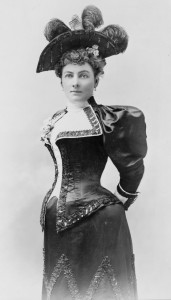
#6 – Proportions
Proportion is another design element that we, not necessarily fail at, but that some costumers get so right. They just hit the nail on the head with their proportions. We’re talking the size of your support garments (hoops & bustles), trims, pockets, collars and cuffs in relation to YOU and your figure size.
It’s taking your body type into consideration when creating your design and in the pattern drafting stage. If the emphasis is on a small waist, you want to design the shoulders and hips to visually reduce that waistline – no matter what your figure looks like. The proportion comes with the fine elements and details of the design.
The Biggest Mistake comes from the “cut & paste” of the pattern into a wearable garment. Where’s the thought that you might have to scale the pocket or collar up because you’re 5’10”? Why are you drowning in 4″ box pleats, or that your bustle apron hangs to the floor?
It’s not only the fit.… The balance of each element of the garment must be given attention in its relationship to all the other parts while reflecting the time period represented.
#7 – Dressmaking Skills
Although most modern home ec techniques can produce a decent historical costume, it’s those details such as using bias to finish raw edges and boning a bodice that makes a costume design stand out.
The mistake here is not working on your skills. The execution of the technique is sloppy.
A machine stitched hem is a FAIL when it comes to historical costuming. NOT boning a bodice because you think it doesn’t matter because you’ll be in a corset is a thought to be avoided.
The only way to up the ante in your dressmaking skills is to keep sewing. Keep learning. Keep repeating over and over and over again those techniques and methods that elude you. One day this Biggest Mistake will be conquered… or at least it’ll get you past the 8th grade home ec class.
#8 – Accessories
You can have the most stunning dress with a striking fit and fantastic fabric, but if you merely pull your hair back into a headband it will look wrong. (Why is it we always leave our hairstyle plan for the event day?)
And it’s not just the hair. It’s the bonnet, the gloves, the shoes, the earrings….
But for those who have stepped from the historical portrait, they’ve put nearly the same amount of research into hair and accessories as their dress. They know a ponytail is out of the question. They wear only wire earrings and very little makeup. Leather gloves adorn hands. Their parasols are not white nylon with ruffle-y nylon lace sewn all over it.
I believe, any accessory is better than no accessory – within reason… leave your hot pink L.A. Gear sneakers at home. I’m talking about: have a straw hat on your head that has a flower pinned to it if that’s all you can afford or it’s all you have. It’s better than nothing. The Biggest Mistake is having NO accessories to complete your costume.
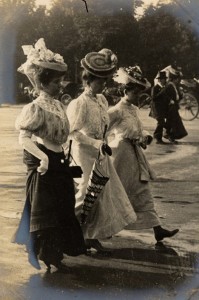
#9 – Attitude & Deportment
One last mistake that historical costumers make is actually when wearing their creation. It’s our attitude. It’s how we behave in our costume. It’s giving our period clothing an injection of proper historical etiquette.
It’s an on-going process, though, this attitude adjustment… because we don’t live back then. These costumes are not our regular clothes that we get up and put on every day… or even every weekend. We don’t do that so they are unusual to us. Our habits and our behaviors are very 21st Century.
When you dress up, you have to act. You have to create your historical persona with all their quirks to bring your vision to reality. Become that character whenever you wear your costumes.
Pay attention to your behavior. Mind your manners. Be authentic. Be 19th Century.
So even using beautiful materials, a precise fit, and standing up straight… It’s ALL the elements combined. You have to consistently do enough projects to get a feel for how the time period drapes and moves and flows.
The Biggest Mistake historical costumers make? They give up when reality doesn’t match the dream in their head.
We are all striving for that “Look” that vision. A good deal of elements have to come together to produce that. And it takes effort. You’re not alone in this. We all fall short of that “perfect” costume. Just keep moving forward and your mistakes will diminish.
Put off that perfectionism and keep the joy in your sewing remembering it’s a journey and not a destination.
What do you think is the Biggest Mistakes historical costumers make?

Hello! I’ve been reading your blog for a refresher course on Regency style, since I’m going to a Bridgerton event in August!
This article was great for me to read, especially the section on getting into the attitude of historical clothes! As an actor who is a VERY lazy cosplayer (hence why I’m throwing together a minimalist Regency-inspired outfit, lol), it’s so painful when I see people in mind-blowing outfits, but they’re only standing and sitting for most of their shots! (Especially for characters from movies/shows and games, where you should have WAY MORE “poses” to reenact!) You need at least a couple of “dress rehearsals” before the actual event, and not just “long enough to check the fit!” Spend at least an hour in it and do regular stuff in your outfit, so you know how it moves and you can break yourself out of the “this is expensive” nervousness!
Take test shots for the poses you have in mind, and fix whatever looks off. Photography/acting needs a LOT more work than most people realize, including for poses. Are your arms at wonky angles? How do you spread out your skirt/cloak/long-and-draping-garment as artfully as possible? How do your accessories behave? Dance a bit, to see how your outfit moves (or not)! How do you look in different lighting? And “blooper shots” are always welcome–lots of people love watching blooper reels from film/TV, or “behind the scenes” shots of actors chilling out in full costume, and part of the reason they’re so fun to watch is because ACTORS SPEND HOURS waiting for their scenes to come around, so they have no choice but to eat breakfast in their medieval plate armor, or to listen to their music playlists in ball-gowns!
If someone’s outfit is spotless, that’s one thing, BUT if their outfit is spotless, they don’t have any poses, and they’re nervous about eating or chilling out, that’s a telltale sign for me that they’re thinking “I spent X-amount of money on this!!!”, so OF COURSE they only turn their persona on for the camera and end up looking like they’re “dressing up for a convention/event,” instead of “wearing historical clothing.”
Great thoughts! Thanks for sharing. And best of luck with your quick Regency ensemble!
I’ve been researching and sewing 16th century clothing for about 20+ years and am just getting into later 19th century clothing, which I’m now obsessed with!! The thing that “makes it or breaks it” for me is wearing glasses that are not period-correct. It just GLARES at me for some reason! I understand some people need to see BUT there must be some way to look more authentic! Also the hair thing! I’ve seen many ladies at ren faires with a nice dress, nice hat and hair worn down like their everyday style! UGH!!! How much better to at least put it up or buy an inexpensive hairpiece??!!!
Also thank you for your great tips, articles and pics!!
My biggest beef is wearing the hat poorly. Pushed to the side or sitting far back when it should be perched forward. I will forgive some bad hair because good hair pieces are really hard to find, but wearing a hat wrong is just carelessness. Get that comb placement in your bonnet set hard so it will hold the bonnet back far enough but not so far back that it leans. In you photo at the front of this piece, comparing what you wanted with what you have the biggest distraction is how you are wearing the hat. The hat doesn’t fit, it isn’t sitting high on your Gibson girl hair. It looks like you got caught in the wind. Yikes!
One last recommendation is about money. It can be expensive, Historical clothing. Especially if you buy the skill instead of developing the skill. My Aunt made the most beautiful suits out of discarded cashmere men’s coats and fine suits. Her skill was extreme. At 67, I am just now beginning to match her skill. But its ok to pick an Historical dress that fits your pay check. Not everyone had money for fine fabrics it acceptable to portray the middle class. In fact picking a Titanic dress from third class well is more interesting than doing the same old first class badly.
I agree with most of your comments in getting headwear set on the head appropriately.
To elaborate, when I first wore that Edwardian outfit I did not have a hat and at last-minute borrowed that one from a friend. I have a very small head and her hat would fall below my eye level if worn properly. I also was not trying to duplicate the original photograph, indicating we are all on a journey with different goals. It was initially my inspiration to get into this time period.
As mentioned at the end of my article, the biggest mistake is giving up instead of keep pursuing the goal we’ve set for ourselves. I have learned a TON since I wrote this article – both in forming a good Edwardian silhouette as well as my sewing skills. Isn’t that why we are here? We keep studying and producing projects that stretch us, and perhaps someday we WILL achieve the look we desire and our “mistakes” will be fewer.
Thank you very helpful. I’m struggling with making a corset and my petticoat I didn’t want tule bc of the noise it makes I want a full flowing movement. I have been encouraged to continue. thank you
Good for you! We can only try our best. I am not a seamstress or dress maker but I try because I just want to have fun. I’m not at these events to check out how accurate the clothing is. I hand sew my outfits and that’s about the most historical I get. Thank you.
I’m new to historical clothing and sewing and I’m planning my first historical ball gown, so let me ask, why should the bodice be boned if I use a corset?
Welcome to our wonderful and Joyful Community!
A corset holds the body in place and provides a smooth base to support the weight of the clothing evenly around the figure.
The boning in a bodice supports the bodice fabric by holding it in place to prevent wrinkles, twisting around the body while wearing or riding up (which is somewhat a fit issue as well). The boning in each garment – corset and bodice – has different purposes and the two should not be confused for each other. Here’s my article on boning bodices.
I would say to keep all your lady bits in the right place. I am very top heavy and the boning keeps it where it belongs. Plus the more boning the better because of you have a large chest there will be more spots to balance the pressure/weight of your chest
My god, I could kiss you for how informative and well-written this is.
Thank you, Megan.
This article covers a lot of important points. One thing I’d like to add is something I’ve seen that many people don’t think of that really affects historical accuracy and throws off the look of a reproduction outfit and that is being tan while representing a time period in which tanning wasn’t fashionable. Too much or the wrong kind of makeup also keeps the costume from looking period correct.
Well said, there is so much to be considered when we work at recreating the past respectfully and thoughtfully. The ‘devil’ absolutely is in the detail!
Mistakes can be made no matter what you are sewing. Modern dress is a little more forgiving with the fit, but you might as well adjust the pattern to your proportions. The biggest thing that screams “handmade” (other than a whimsical fabric choice) is that they don’t iron enough, or improperly, or at all.
Is the ironing step important in period costume? Would the dressmakers have ironed as they were sewing a dress?